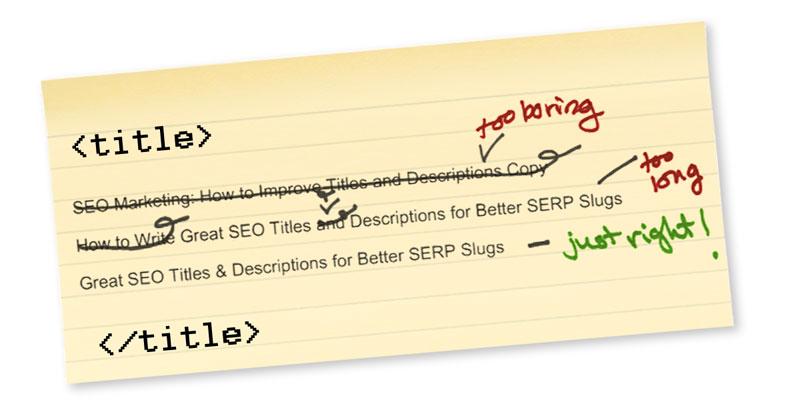Great SEO Titles & Descriptions for Better SERP Slugs

Modern SEO: Write for People, not Search Engines
The world keeps changing and so does Google’s algorithm. As we outlined in a recent post, SEO Food For Thought: Ranking Factors to Help Your SERP Position, Machine Learning, along with CTR, Time on Site and other factors, all help Google to better understand that they’re delivering what humans want—quality content. The more Google delivers quality content, what people are really looking for when they search, the more-likely people will continue to use Google and the more money Google makes. So, to improve your SERP slugs all you need to do is write engaging titles and descriptions. Sounds easy, right?
Shifting Title and Description Parameters
Recently, Google changed the space available for titles and descriptions, allowing titles to go from 60 characters to approximately 70 characters and descriptions to increase to approximately 156 characters. Why approximately? Because for Google, it’s all about the pixels. In fact, they increased their pixel length from 500 to 600 pixels and everyone has just translated this into an approximate character count before Google will likely truncate and add in the ellipsis. The English language is full of different sized letters, some fat and some thin, and different sized words, some long and some short. At first blush measurement via pixel length likely affords more space to marketers, but at the cost of not really having a hard rule for length; it always depends on the words that you chose and the letters that make up the words. And Google also bolds the keywords in titles, descriptions and URLs that were used in the search query. All of which leaves marketers having to score while the goal posts keep shifting.
Do We Need To Pull Out a Measuring Tape?
No, there are some free and paid for tools, such as SEOMofo or Screaming Frog, that let you type in your title and description and they truncate your verbiage as Google would (you can also test to see what happens when you bold certain keywords). Although lots of SEO gurus have seen titles and descriptions longer than the character counts given, we recommend you keep them under the maximum character counts above while also always testing them in one of the SEO tools before publishing. A good rule of thumb is to still put your most important keywords at the beginning of the sentence to avoid any accidental truncation. And always remember it’s really a human being that we need to engage enough to click-through (and be rewarded by staying on the page or visiting more pages once they finish with the content they originally intended to review).
Which Brings Us Back to Writing Engaging Content
Keywords, of course, still matter. But with the changes in Google’s algorithm, they don’t matter like they once did and marketers no longer need to stack their headlines with an endless stream of keywords, or have the most important keyword first, which used to often lead to boring headlines and descriptions read by computers but not people.
For example, the old style of writing the heading for this blog post might have been this (under 60 characters with spaces):
SEO Marketing: How to Improve Titles and Descriptions Copy
The new style would be more like this (68 characters):
How to Write Great SEO Titles and Descriptions for Better SERP Slugs
But wait, when we tested out the line, Google truncated in the middle of the acronym SERP. Why? The title is only 68 characters long, but because it’s mainly short words with fat capitals, it went over the pixel length allocated. So, after some brainstorming, a few revisions and tests, we’ve decided on the following title, which communicates what we need it to, while staying under the pixel length.
Great SEO Titles & Descriptions for Better SERP Slugs
So, the secret to writing great titles and descriptions is to pay attention to the cornerstone of SEO, such as keywords, but write ultimately for people first. Figure out the best copy to not only engage people to click, but that also communicates clearly what the content is so your title and descriptions deliver the right people to the relevant content you want to share.
